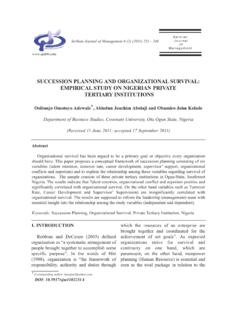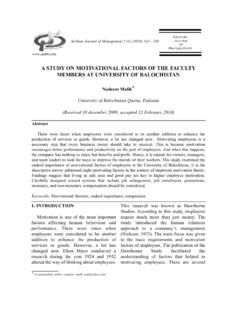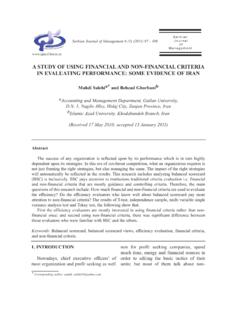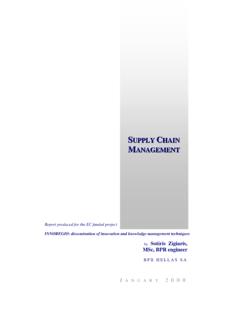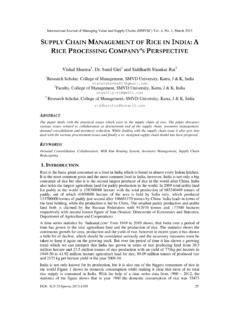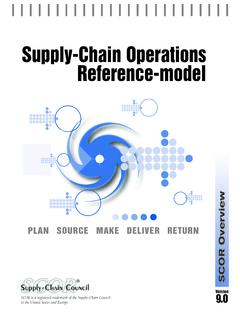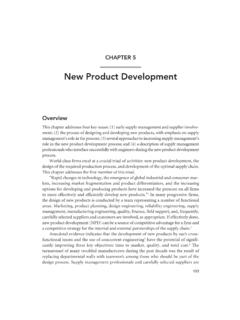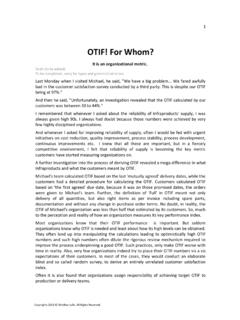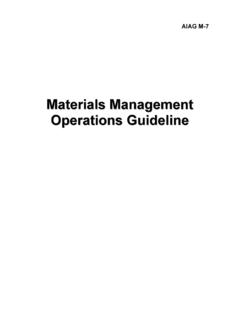Transcription of DEVELOPMENT OF A SPREADSHEET BASED VENDOR …
1 DEVELOPMENT OF A SPREADSHEET BASED VENDORMANAGED inventory MODEL FOR A SINGLE ECHELONSUPPLY chain : A CASE STUDYA rumugam Mahamani and Karanam Prahlada RaoaSudharsan Engineering College,Pudukkottai-622501(TN), IndiabJNTU College of Engineering, Anantapur-515002 ( ), India(Received 12 February 2010; accepted 12 June 2010)AbstractVendor managed inventory (VMI) is a supply chain initiative where the supplier assumes theresponsibility for managing inventories using advanced communication means such as onlinemessaging and data retrieval system. A well collaborated VENDOR manage inventory system canimprove supply chain performance by decreasing the inventory level and increasing the fill rate. Thispaper investigates the implementation of VENDOR managed inventory systems in a consumer goodsindustry.
2 We consider (r, Q) policy for replenishing its inventory . The objective of work is tominimize the inventory across the supply chain and maximize the service level. The majorcontribution of this work is to develop a SPREADSHEET model for VMI system, Evaluation of Totalinventory cost by using SPREADSHEET BASED method and Analytical method, Quantifying inventoryreduction, Estimating service efficiency level, and validating the VMI spread sheet model withrandomly generated demand. In the application, VMI as an inventory control system is able to reducethe inventory cost without sacrificing the service level. The results further more show that theinventory reduction obtained from analytical method is closer to the spread sheet BASED approach,which reveals the VMI success.
3 However the VMI success is impacted by the quality of buyer-supplier relationships, the quality of the IT system and the intensity of information sharing, but notby the quality of information : SPREADSHEET , analytical model, VENDOR managed inventory , random demand, inventorycontrol, service level*Corresponding author: Journalof ManagementSerbian Journal of Management 5 (2) (2010) 199 - 211 INTRODUCTIONThe management of inventory by thesupplier continues to draw attention in manyindustries. The coordination of logistics ofinventory decisions in a supply chain has asignificant effect on the supply chainperformance (Lau et al., 2008;Madhusudhana et al., 2008). In vendormanaged inventory system VENDOR orsupplier is given the responsibilities ofmanaging the customer s stock.
4 Thefundamental change is that the orderingphase of the process is saved, and thesupplier is handed the authority andresponsibility to take care of entirereplenishment process. This integratesoperations between suppliers and buyersthrough information sharing and businessprocess reengineering (Cetinkaya & Lee,2000). By using information technologiessuch as electronic data interchange, buyerscan share the inventory information withsuppliers on a real time basis. Suppliers canthen use this information to plan productionruns, schedules, deliveries and manage ordervolumes and inventory levels at the buyer sstock keeping units (Blackhurst, et al. 2006)There are many advanced modelsavailable in literature like single set-up,multiple delivery, VENDOR managed inventoryand 3C (commonality, consume andcapacity) as well as advanced methods likefuzzy logic, transfer function and modelreference control.
5 However there are plentyof researchers attempting to find answers tosupply chain it becomes harder to understandthese optimization models when complexityof the problem increases. An analyticsolution to a problem may not be availablebecause of a stochastic operatingenvironment, an extremely complex problemor very specific problem (Banks & Malave1984).In their busy daily business world, inventory managers usually do not haveenough time to try and implement suchchallenging models. Up to now operationresearch specialists have developedapproximately 400 inventory models toreplicate inventory strategies and to describethem mathematically. However experienceshows that there are very few practicalapplications (Bona, 2004; Kollurua andPonnam, 2009).
6 The main reason is that theapplication of the model is frequently tied toconstraints that cannot be met in realstochastic processes. The application of anexact mathematical formula to define thetarget function required for the optimizationis usually very difficult. Analytical solutionsusing mathematical tools such as probabilitytheory and optimization can be used toobtain the performance level of the inventorysystem. Unfortunately, the analyticalmodeling of complex supply chains islimited to underlying mathematicalassumptions that make the mathematicstractable. The mathematical formulation forinventory policy is hard to solve analytically,and does not lend itself to analyzing severalordering polices (Ravichandran 2007).
7 Today spreadsheets are used as aprogramming language. Most researchershave used MS Excel software simulationmodeling except (1997). Hedemonstrated the simulation model for woodyard inventory control. Zhang et al 2001;Gandhi 2003; Sezen et al 2007; Boute etal2003; Jung et al 2007; Ravichandran 2007;Mahamani et al 2006 and Mahamani et al2008 used a SPREADSHEET - BASED approach forinventory control problems. Thesesimulation software packages require a costconsideration for the program, the time tolearn and the appropriateness to the specificneeds of a company (Sezen & Kitapci, / SJM 5 (2) (2010) 199 - 2112007). Conversely, spreadsheets are simpler,inexpensive and can be developed usingavailable resources ( , MS Excel, QuattroPro and Lotus 123).
8 Simulation modelsdeveloped on spreadsheets are flexible; theuser gains software skills in short period oftime, board availability, ease of use, easyvalidation and low price. This paperinvestigates the implementation of vendormanaged in inventory systems in a consumergoods industry. Once the data were setup inspreadsheet, two axis graphs were used forpolicy comparison. The planning horizon forsystem was one calendar LITERATURE REVIEWV endor managed inventory is a system inwhich the supplier decides on the appropriateinventory levels of each of the products andthe appropriate policies to maintain theselevels. Yao et al (2007) developed ananalytical model that explores how importantsupply chain parameters affect the costsaving to the realized from collaborativeinitiatives such as VMI.
9 Result from themodel shows that benefits in the form ofinventory cost reduction. Mohamed et al(2004) proposed a VMI system, withassumption that the VMI will have to rentstorage and shelf spaces in the back roomshowroom facilities, respectively, to stockand display the items. The VMI has to decideabout the timing and sizing of each order forthe store and the maximum shelf space to bereserved for each item.. Gronalt et al (2008)demonstrated a case study from woodprocessing industry by using vendormanaged inventory system. The evaluationof VMI implementation against the actualinventory management for three differentmarket sceneries. The application background, VMI as an inventory control systemis able to reduce overall raw material stockby more than 37% by simultaneouslyincreasing the service level.
10 Claassen et al(2007), presented as an empiricalinvestigation on performance outcome ofVMI. The result show that VMI leads tothree performance outcomes: highercustomer service level, improved inventoryplanning and a lesser extent, cost 2004 et al examines the relationshipbetween distributor backorder performanceand its inventory levels under VendorManaged inventory (VMI) in a supply chainthat consists of distributors andmanufacturers. We construct a principal-agent model to show that distributors inventory managed by manufacturers can beused to induce distributor efforts, which areunobservable to the manufacturers, inconverting lost sales into backorders in thecase of stock outs.

